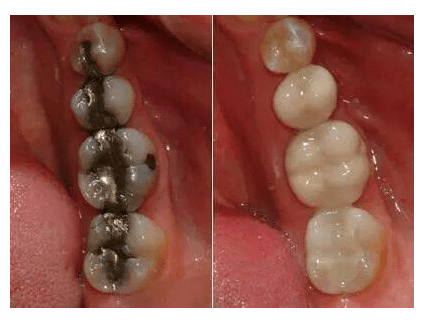A dental filling is a restorative material that is placed in your tooth to restore the function and integrity of missing tooth structure. The structural loss typically results from decay, malformation of teeth or fractures caused by trauma. The decayed material is then removed, the tooth is cleaned and then filled. When you need a cavity filled, you have a variety of options.
Amalgam (Silver) Fillings
Used for more than a century, dental amalgam is the most thoroughly researched and tested restorative material among all those in use. It is durable, easy to use, highly resistant to wear and relatively inexpensive in comparison to other materials. For those reasons, it remains still is a treatment option for our patients. they are sometimes called silver fillings because of their color. However, we rarely use amalgam because almost all of our patients understandably request white or tooth colored fillings.
Dental amalgam is a stable alloy made by combining elemental mercury, silver, tin, copper and other metallic elements. Some concern has been raised about the safety of amalgam because of its mercury content. There are many conflicting studies on this matter, However The American Dental Association has concluded that dental amalgam is safe to use as a restorative material, because the mercury in amalgam combines with other metals to render it stable and safe for use in filling teeth. If you have any doubts or concerns about using amalgam, we recommend using porcelain or composite restorative materials because they work very well and have better esthetics than amalgam.

Because amalgam fillings can withstand very high chewing loads, they are particularly useful for restoring molars in the back of the mouth where chewing load is greatest. They are also useful in areas where a cavity preparation is difficult to keep dry during the filling replacement, such as in deep fillings below the gum line. They do tend to oxidize and look dark or black over the years.
Composite (White) Fillings
Composites (white fillings) are the most common filling material used currently because they are relatively low cost, they matched the color of your tooth and can often be placed in one visit. Composite fillings are a mixture of glass or quartz filler in a resin medium that produces a tooth-colored filling. They are sometimes referred to as filled resins. Composite fillings provide good durability and resistance to fracture in small-to-mid size restorations that need to withstand moderate chewing pressure. Less tooth structure is removed when the tooth is prepared, and this may result in a smaller filling than that of an amalgam or porcelain. Composites are “bonded” and adhesively held in the tooth cavity, often allowing for a more conservative repair to the tooth. At Tarzana Dental Care we use the best and most expensive composite materials available on the market. Our filling materials release fluoride inside the tooth which helps reduce sensitivity and protects tooth structure from re-decay.
It generally takes longer to place a composite filling than what is required for an amalgam filling. The tooth has to be especially isolated, prepared, cleaned and bonded during filling. The drawbacks for Composites are that they are not as strong as amalgam and porcelain fillings, they are subject to stain and discoloration over time and they may cause slightly more post-operative sensitivity when compared to amalgam and porcelain fillings.
Porcelain Fillings (Inlays)
Porcelain fillings are made in a dental laboratory and are custom made for each tooth. They resist staining, and are made to match the tooth. They might be recommended if the decayed area is large or if you clench and grind your teeth. The benefit of Porcelain fillings is they are very natural-looking and are stronger than white composite fillings. They last longer than white fillings but are more expensive and require two visits to fabricate and place.
